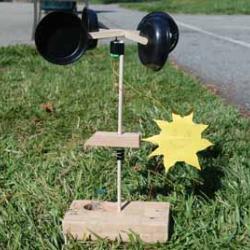Source Institutions
Source Institutions
Add to list Go to activity

In this meteorology activity, learners construct simple devices to measure the direction and speed of wind. Learners will explore wind and air resistance as well as how weather vanes and generators work to analyze weather patterns. Note: a drill and other specialty tools are required for this activity, but are not included in the cost of materials. [Activity is publicly available through a web crawler capture on Archive.org.]
- Under 5 minutes
- 30 to 45 minutes
- $5 - $10 per student
- Ages 6 - 18
- Activity, Lesson/Lesson Plan
- English
Quick Guide
Materials List (per student)
- 12" dowel, 1/4"
- 1 baseboard, 2x4
- 1 wood block, vane: 4"x1/2"x1/2"
- 1 wood block, top: 1/2"x1/2"x1/4"
- 4 small plastic cups
- 4 craft sticks
- 1 bamboo skewer
- 1 nut or washer
- 2 electrical wires, 12" long
- 1 thin nail bit
- 1 19/64 drill bit
- 1 ammeter
- drill
- paper
- electrical tape
- glue gun
- wire strippers
- 1 binder clip
Subjects
-
Earth and Space Science
-
Earth Processes
- Weather and Climate
-
Earth Processes
-
Engineering and Technology
- Technology
-
Physical Sciences
-
Electricity and Magnetism
- Electric Motors
- Electric Circuits
-
Energy
- Energy and Power
-
Motion and Forces
- Momentum and Velocity
- Rotation Motion
-
States of Matter
- Gases
-
Electricity and Magnetism
-
The Nature of Science
-
The Scientific Process
- Conducting Investigations
-
The Scientific Process
-
The Nature of Technology
-
Technology and Society
- Technology and History
-
Technology and Society
Informal Categories
- Nature and Environment
- Outdoor Activity
Audience
To use this activity, learners need to:
- see
- touch
Learning styles supported:
- Uses STEM to solve real-world problems
- Involves hands-on or lab activities
Other
Components that are part of this resource:
Includes alignment to state and/or national standards:
This resource is part of:
Access Rights:
- Free access
By:
- Watsonville Environmental Science Workshop
Rights:
- All rights reserved, Watsonville Environmental Science Workshop, 2011
